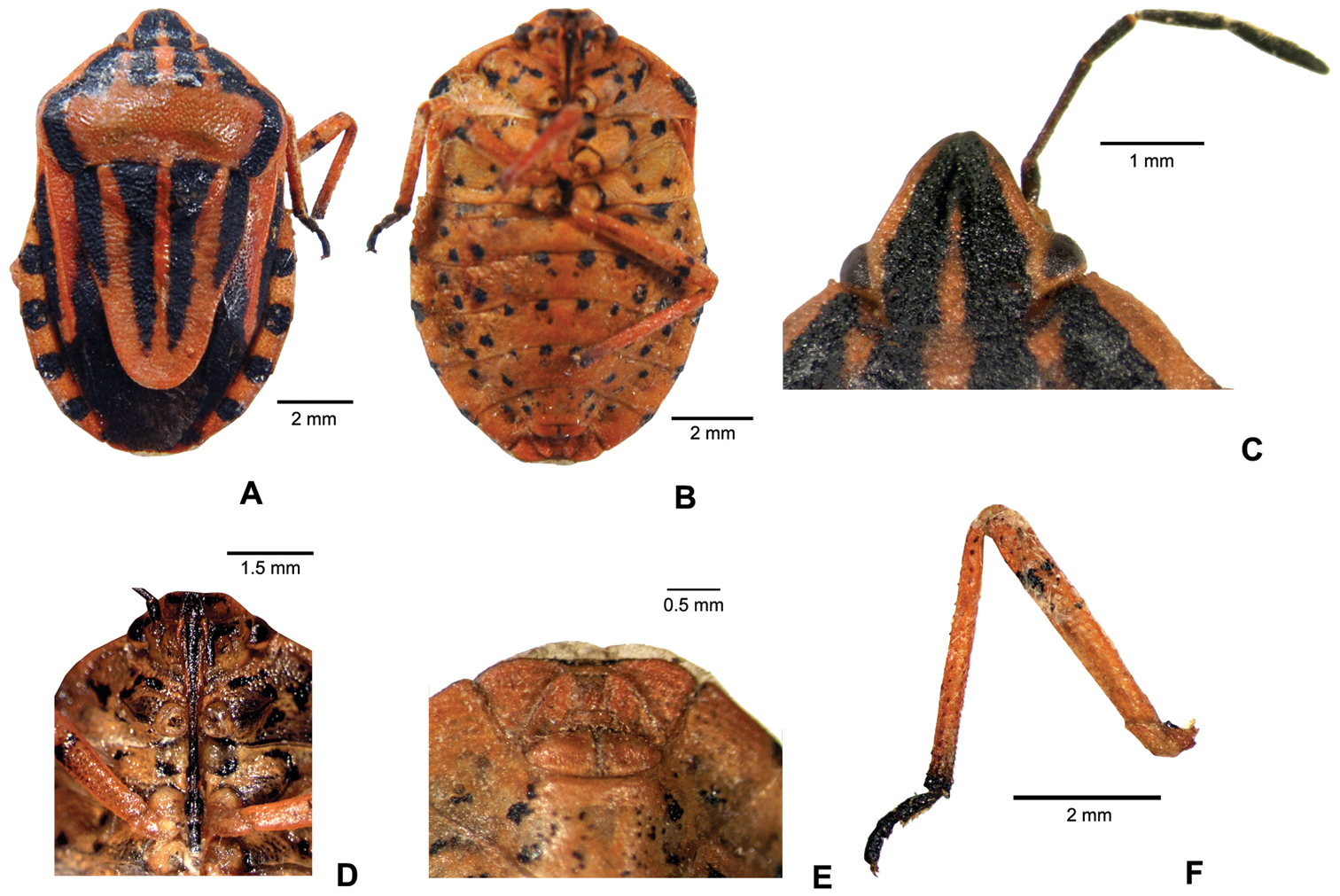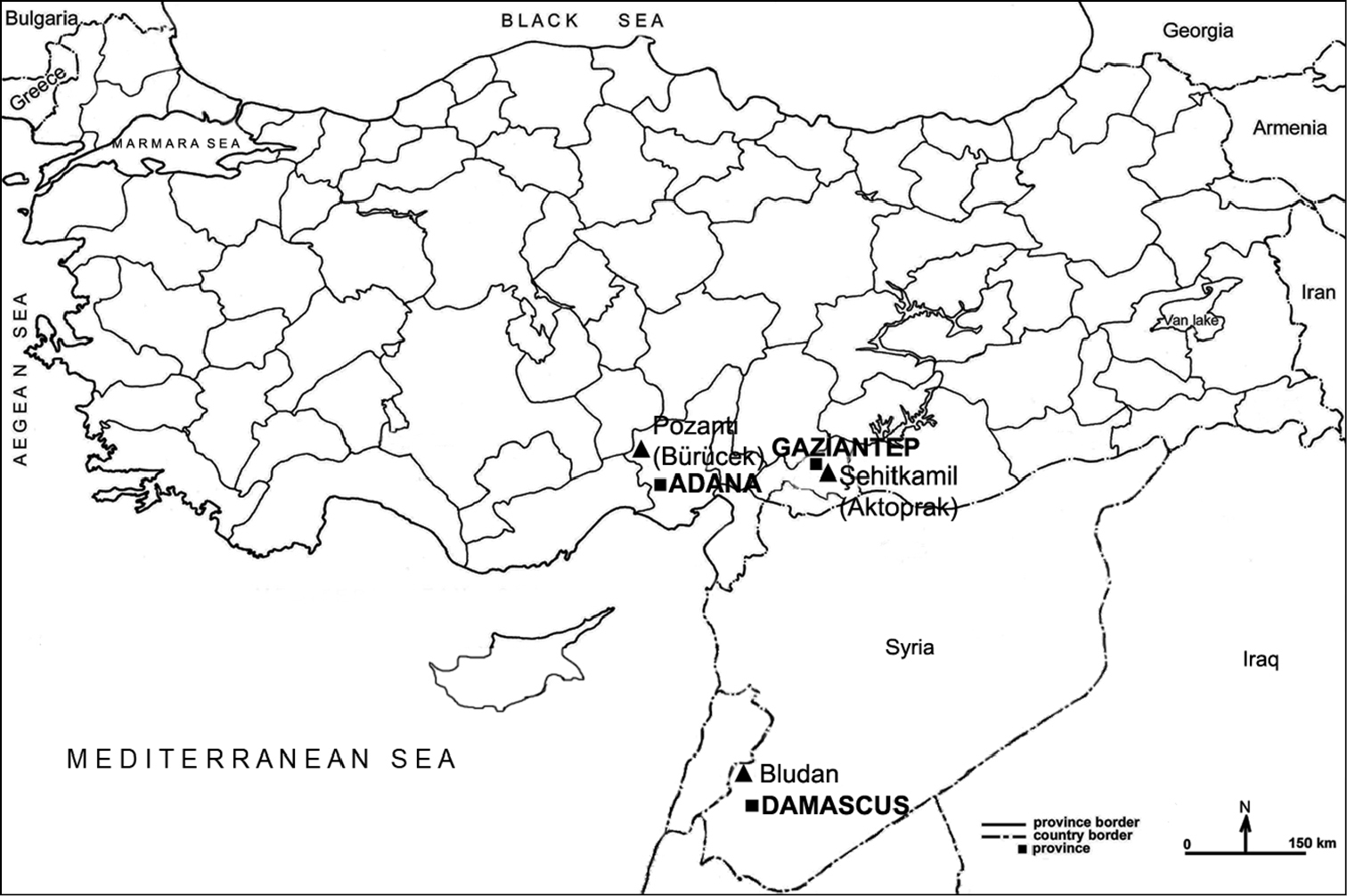






(C) 2013 Meral Fent. This is an open access article distributed under the terms of the Creative Commons Attribution License 3.0 (CC-BY), which permits unrestricted use, distribution, and reproduction in any medium, provided the original author and source are credited.
For reference, use of the paginated PDF or printed version of this article is recommended.
Citation: Fent M, Dursun A, Tezcan S (2013) First record of Graphosoma inexpectatum (Hemiptera, Pentatomidae, Podopinae) from Turkey with description of the female. In: Popov A, Grozeva S, Simov N, Tasheva E (Eds) Advances in Hemipterology. ZooKeys 319: 51–57. doi: 10.3897/zookeys.319.4298
Graphosoma inexpectatum Carapezza & Jindra, 2008 is described from Syria, the southern neighbor of Turkey, and is known only from the type locality. The first observation of the species in Turkey dates back to 1995 with two females obtained from the provinces of Gaziantep (Şehitkamil–Aktoprak) and Adana (Pozantı–Bürücek Plateau). These two localities are situated inside the part of the Mediterranean region along the Syrian border. Females of the species, whose original description was based on males, are described here for the first time. A map showing the collecting localities and photographs of the female specimens are given.
Hemiptera, Pentatomidae, Podopinae, Graphosoma inexpectatum, female description, first record, Turkey
Graphosoma Laporte, 1833 is a Palaearctic genus belonging to the subfamily Podopinae Amyot & Serville, 1843 of the family Pentatomidae Leach, 1815. It is subdivided into two subgenera and includes nine species/subspecies (Graphosoma s.str. with eight species and Graphosomella Carapezza & Jindra, 2008 with one species). Among these nine species, Graphosoma inexpectatum Carapezza & Jindra, 2008, the only representative of Graphosomella, and the following six species of Graphosoma s.str. are distributed in Turkey: Graphosoma lineatum (Linnaeus, 1758), Graphosoma semipunctatum (Fabricius, 1775), Graphosoma melanoxanthum Horváth, 1903, Graphosoma stali Horváth, 1881, Graphosoma consimile Horváth, 1903 and Graphosoma alkani Lodos, 1959 (
Among the Turkish representatives of the genus, the type localities of Graphosoma stali and Graphosoma alkani are in Turkey. Graphosoma stali was previously identified as Graphosoma lineatum var. stali by Horváth in 1881 from Asia Minor (
Graphosoma (s.str.) interruptum A. White, 1839 distributed only on the Canary Islands and Graphosoma (s.str.) rubrolineatum (Westwood, 1837) distributed in the Far East (China, Japan, Korea, Mongolia and Russian Far East) do not occur in Turkey (
Graphosoma (Graphosomella) inexpectatum Carapezza & Jindra, 2008, the only species of the subgenus Graphosomella Carapezza & Jindra, 2008, is described from Syria (type locality: SW Syria, Bludan) based on two male specimens and has not been recorded in any other place so far. Two females were obtained during the present study from Adana and Gaziantep provinces, which are both very close to Syria.
The study material was collected in June–July of 1995 in two southern provinces of Turkey, Gaziantep (Şehitkamil–Aktoprak) and Adana (Pozantı–Bürücek Plateau), using a sweeping net. Aktoprak is a district of the city Şehitkamil. This area, located on the border between the southeastern Anatolian and Mediterranean regions of Turkey, has a transition climate which includes both Mediterranean and continental climate characteristics. Winters in the area are cold and wet, and summers are hot and dry. As a result of the climate, the flora of this territory is transitional between the vegetation types of the Mediterranean and the steppe elements of the southeastern Anatolian regions. Although forests are rare, the dominant trees oak (Quercus sp.) and red pine (Pinus brutia Ten.) were chosen in forested areas (www.markasehir.com/siteic.php~id=&altno=23&back=false.html).
The second locality, Bürücek Plateau, is 100 km away from Adana city center and is an upland with an altitude of 1300 m surrounded by pines (Pinus spp.), junipers (Juniperus spp.) and fruit trees at the foot of the Akdağ Mountains, Middle Taurus. Pozantı is 7 km away from the Bürücek Plateau and is under the effect of a Mediterranean climate with cold and wet winters and hot and dry summers. Snowfall is typical for winter, and rainfall, during the spring. Despite the hot weather conditions in spring and autumn, Bürücek Plateau is cool even in summer. The area is characterized by the Mediterranean phytogeographical region’s vegetation formations under the influence of the climate. The dominant tree of the upland is generally the red pine (Pinus brutia Ten.) but the amount of mixed forest areas including both black pines (Pinus nigra Arnold) and red pines increases with higher altitudes; at higher altitudes black pine, cedar (Cedrus libani A. Rich.) and fir (Abies cilicica Carr.) formations exist in either mixed or pure areas. In addition, trees such as Syrian juniper (Juniperus drupacea Lab.), ash (Fraxinus excelsior L.), oak (Quercus sp.), willow (Salix sp.), hornbeam (Carpinus betulus L.), European cornel (Cornus mas L.), European bladdernut (Staphylea pinnata L.), hawthorn (Crataegus sp.), blackberry (Rubus fruticosus L.), service tree (Sorbus domestica L.) and spruce (Picea sp.) and annual plants such as St. John’s worth (Hypericum perforatum L.), oregan (Origanum vulgare L.), thyme (Thymus vulgaris L.), speedwell (Veronica officinalis L.), wild garlic (Alium ursinum L.), chard (Beta vulgaris var. cicla L.), salep (Orchis mascula L.), horsemint (Mentha longifolia L.) and colchicum(Colchicum autumnale (L.)) are commonly seen (www.adanaliyiz.org/index.php?topic=48.0;wap).
Gaziantep province: Şehitkamil (Aktoprak), 11.VI.1995, 37°11'00"N, 37°17'00"E, ca 1035 m, 1 ♀, leg. F. Önder; Adana province: Pozantı (Bürücek Plateau), 2.VII.1995, 37°25'40"N, 34°52'18"E, ca 1300 m, 1 ♀, leg. F. Önder (coll. Trakya University, Edirne, Turkey and Ege University, LEMT, İzmir, Turkey).
The host plants for both specimens were recorded as weeds, so the plant on which specimens were collected is not known exactly.
(Fig. 1). Body ovoid, flat, moderately deep punctate and glabrous. Coloration pattern of body with black lines and markings on orange as in most species of Graphosoma. Body 1.75–1.80× as long as pronotum width. Body is slightly greater than in males (10.3–11.3 mm versus 10.66–10.80 mm) (Fig. 1A).
Head almost subtriangular, lateral sides nearly flat. Head: 1.77–1.99 mm long and 0.76–0.82× longer than wide across eyes; width across eyes 2.32–2.41 mm, interocular width 1.52–1.65 mm; jugae enclosing and widely exceeding the tylus, slightly diverging apically. Dorsal surface of head deeply punctate. Integument orange, with two black bands tapering and fusing distally. Length of antennomeres I: 0.54–0.62 mm, II: 1.0–1.13 mm, III: 0.64–0.66 mm, IV: 0.7–0.9 mm, V: 0.95–1.06 mm. First and second antennomeres are the shortest and the longest respectively. First antennomere brownish, yellowish distally; IV and V antennomeres dark brown (Fig. 1C). Antennae/Body length: 0.37–0.38. Head ventrally orange, anterior angle of eye with small black subtriangle spot, jugae anteroventrally with transverse black spot (Fig. 1D).
Pronotum transverse, 5.87–6.29 mm wide across lateral angles and 1.92–2.22× wider than long in the middle. Pronotum anteriorly rather narrower than posteriorly, lateral margins evenly rounded. Dorsal surface of pronotum deeply punctate and orange, anterior part with four longitudinal black bands, the external ones at their posterolateral angles joining two curved black bands running parallel to posterior half of lateral pronotal margin (Fig. 1A).
Scutellum subtriangular, distally widely rounded, 5, 4–6, 3 mm long and 1.28–1.34× longer than basally wide; contrary to species of Graphosoma s.str., scutellum does not reach to the end of abdomen and covers only two thirds of abdomen length. Lateral margins of scutellum convex in proximal half. Proximal margin of scutellum medially with a raised semicircular punctureless area between the internal margins of two lateral black bands; lateral margins of semicircular area extend to internal margins of lateral bands. Scutellum orange with four long black bands; lateral bands shorter than median ones, distally almost pointed and extending to half length of scutellum; median bands long but not reaching the apex of scutellum (Fig. 1A).
Hemelytra orange except for a triangular blackish brown spot at the apex of r+m vein, the external margin of exocorium with longitudinal black spot, distal with triangular spot, membran blackish–brown (Fig. 1A).
Paratergites with black spots along distal and proximal margins, spots of adjoining tergites merging to form an almost circular shape (Fig. 1A).
Abdomen maximum width 6.88–6.99 mm and 1.09–1.17× wider than long, ventrally orange and with irregular black spot. Proximal and distal angles of parasternites with black spots (Fig. 1B).
Rostrum reaching hind coxae; first three segments yellowish, IV dark brown (Fig. 1D). Length of rostral segments I–IV: 1.56, 1.13, 0.82, 0.53 mm.
Legs orange, femora ventrally with two preapical black spots, apex of tibiae black, tarsi black (Fig. 1F).
Female genitalia reddish–brown, with shallow punctures. Eight gonocoxites convex, 9th gonocoxites medially excavated, lateral margins with black lines and centrally with black mark (Fig. 1E).
Graphosoma inexpectatum. A body, dorsal view B body, ventral view C head, dorsal view, and antenna D head, ventral view, and rostrum E female genitalia F leg, lateral view.
The two female specimens examined in the present study show some differences in morphology and coloration when compared with the holotype of the species whose original description by
Two female specimens of Graphosoma (Graphosomella) inexpectatum were obtained in 1995 from two localities in Adana and Gaziantep provinces in the Mediterranean region of Turkey. This is the first record of the species in Turkey and the second record in the world. The number of Graphosoma species in Turkey rises to seven with this record. The presence of seven species of Graphosoma in Anatolia, out of the nine overall known in the genus, reinforces the notion that Anatolia and its immediate vicinities, as indicated by
This species was first described by
Distribution of Graphosoma inexpectatum.

